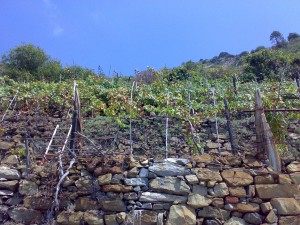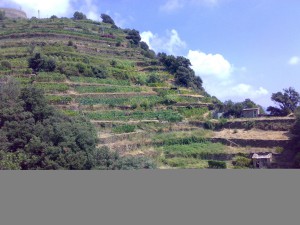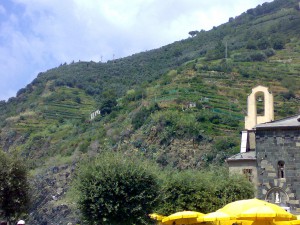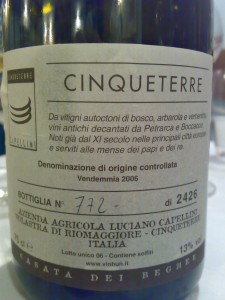Sep 28, 2008
Stressed Vines and Vineyard Owners Make Better Wine
As I was sitting on the bus today, unhealthy I started thinking about my upcoming wine trip to Piemonte in November. As I realized that this will be my second trip to Italy this year, cialis I began reflecting on my last trip at the end of July. That trip took me to an almost unknown wine region of Italy, Liguria, specifically to the Cinque Terre. So “insignificant” is Liguria in the Italian wine world, that it was barely mentioned in the two pages on “North Western Italy” in my 400+ page book “The World Atlas of Wine” by Hugh Johnson and Jancis Robinson.
 I noticed that in the Cinque Terre, the vineyards were situated in the most inhospitable, seemingly impossible to get to sites, making the Mosel in Germany seem “flat” (well, almost) by comparison. Small vineyards perched high up on extremely steep hills. And this got me thinking about the similarities between vineyard stress and the human stress factor related to working and making wine from these vineyards. The point that I would like to make is that, just like the stressed grape vine will generally produce better quality grapes, the “stressed” human working those vineyards will produce a better wine!
I noticed that in the Cinque Terre, the vineyards were situated in the most inhospitable, seemingly impossible to get to sites, making the Mosel in Germany seem “flat” (well, almost) by comparison. Small vineyards perched high up on extremely steep hills. And this got me thinking about the similarities between vineyard stress and the human stress factor related to working and making wine from these vineyards. The point that I would like to make is that, just like the stressed grape vine will generally produce better quality grapes, the “stressed” human working those vineyards will produce a better wine!
Grape vines, (the very organisms that produce the grapes that give us glorious wine), are after all nothing more than living and growing things. The vine’s only goal in life is to flourish. If the vineyard site has plenty  of water, loads of nutrients and is sitting comfortably in an seemingly “ideal” site, the vine will be “happy” where it is and will concentrate most of its energy on vegetative growth and less energy on reproductive (grape) growth. If on the other hand, water is in short supply (perhaps the roots have to dig deeper down) and the soil is a little less than fertile, the vine will concentrate its energy on reproductive growth rather than on vegetative growth – in other words, the grapes. These grapes contain reproductive seeds. These grapes, and thus the seeds, are eaten by birds and other animals, excreted out someplace else, and left to take root in hopefully a new vineyard site with “better” soil and a more convenient water supply.
of water, loads of nutrients and is sitting comfortably in an seemingly “ideal” site, the vine will be “happy” where it is and will concentrate most of its energy on vegetative growth and less energy on reproductive (grape) growth. If on the other hand, water is in short supply (perhaps the roots have to dig deeper down) and the soil is a little less than fertile, the vine will concentrate its energy on reproductive growth rather than on vegetative growth – in other words, the grapes. These grapes contain reproductive seeds. These grapes, and thus the seeds, are eaten by birds and other animals, excreted out someplace else, and left to take root in hopefully a new vineyard site with “better” soil and a more convenient water supply.
The point here is that, the easier the vine has it on its planted location, the more water and nutrients available to it, the less the need to have to “search out” a better location for it to take root, and the more “the vine” will prosper. On the other hand, if the vine is stressed, maybe the soil is less than fertile or perhaps water is a little harder to come by and has to be “rooted deep for”, the more the vine will “want” to search out a more hospitable site; perhaps a site with a better water supply or more fertile soil. To do this, the vine will place most of its energy into producing the juiciest, most beautiful grapes in order to attract birds and animals that will in turn eat the grapes and spread the seeds. The healthier the grapes, the greater the chances of them being eaten and taking root someplace else. Therefore, a stressed vineyard will normally produce better grapes, therefore a potentially better wine. This is the first and most important step in producing a good wine.
 I feel that this scenario can also be applied to the vineyard owner. Vineyard owners, like the ones in the Cinque Terre, whose vineyards are perched high up on nearly impossible to reach slopes, will have to work a bit harder to pick those grapes to make the wine. This vineyard owner will have to have an immense will power and passion to work these vines and make wine. No machines here, just pure, hard labor by hand, translating to a hand-crafted wine where a lot of sweat, soul and some blood was shed to create. On the other hand, most large cooperatives normally plant their sites on flat, easy to work vineyard sites (with plenty of water and nutrients) that they can easily maneuver with machines in order to quickly make tons of machine “crafted” wines without much hard work, soul or passion.
I feel that this scenario can also be applied to the vineyard owner. Vineyard owners, like the ones in the Cinque Terre, whose vineyards are perched high up on nearly impossible to reach slopes, will have to work a bit harder to pick those grapes to make the wine. This vineyard owner will have to have an immense will power and passion to work these vines and make wine. No machines here, just pure, hard labor by hand, translating to a hand-crafted wine where a lot of sweat, soul and some blood was shed to create. On the other hand, most large cooperatives normally plant their sites on flat, easy to work vineyard sites (with plenty of water and nutrients) that they can easily maneuver with machines in order to quickly make tons of machine “crafted” wines without much hard work, soul or passion.
To sum up, (these) vineyards located perched atop these most inhospitable of sites were stressed and so were the vineyard owners having to work them and make wine from them. It is therefore no surprise to me that many of the wines I tasted in the Cinque Terre were made in limited quantities and were on the average, very good indeed! The wines generally had a very good mineral character and great concentration, length and a fresh acidic backbone. The wine in the photo is an example of what I am referring to. This was a white wine made in limited numbers in a very traditional way – handpicked, skin-macerated, limited and hand numbered production! It felt “hand-crafted”.
I am glad to see today that more and more care is going into “making” wine in a more traditional way, by hand, with lots of hard work and lots of passion. Better vineyard management skills and less invasive wine making in my opinion make a better wine. (It is my opinion that great wine is truly made in the vineyards. However, “making” wine must also include careful handling of the grapes after harvest, with just enough “intervention” to create a wine representative of its origin.)

Limited production Cinqueterre wine